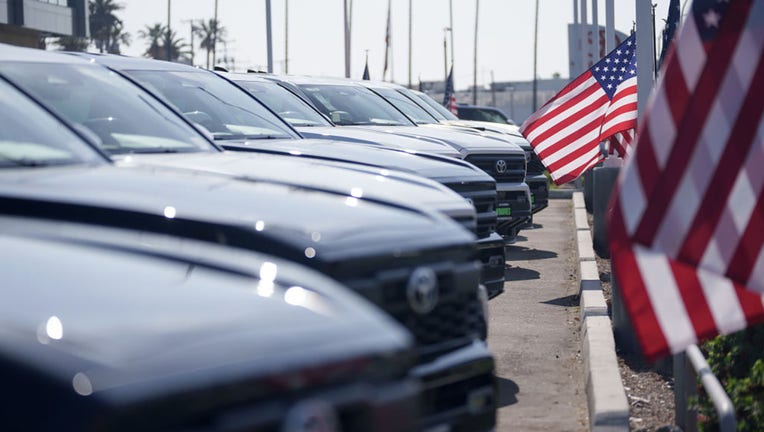Car insurance premiums could skyrocket 50% in some states this year

FILE - A car dealership in Alhambra, California, on June 27, 2024. Photographer: Eric Thayer/Bloomberg via Getty Images
Car prices are finally on the down swing, but drivers are facing a new financial hurdle: surging auto insurance premiums.
A new report published by Insurify, an insurance comparison shopping site, shows the average U.S. rate for full auto insurance surged to $2,329 in the first half of 2024. That marks a 15% increase from 2023 and a stunning 48% spike when compared with 2021.
By the end of 2024, the cost of coverage is expected to rise even further, to $2,469, according to the report.
The problem is even worse in some states, where prices are projected to rise more than 50% this year.
HEALTH CARE COSTS FOR RETIREES CONTINUE TO SOAR
Minnesota
Prices are expected to rise most sharply in Minnesota, with a projected increase of 61%. That would bring the average annual cost of full coverage in the state to $2,597, from the current level of about $2,315, according to the report.
One reason for the spike is the increased risk of severe weather events. In 2023, Minnesota recorded $1.8 billion in damages due to a severe storm that produced hail the size of golf balls and baseballs, Insurify data insight manager Chase Gardner told FOX Business.
"These states have been historically considered severe weather safe havens," Gardner said. "But insurance companies are having to reassess that risk in the state."
Gardner also noted that insurance fraud is on the rise in Minnesota. According to the Minnesota Commerce Fraud Bureau, the state saw an 11% increase in insurance fraud investigations in 2020 compared with 2019. That also marks a 57% increase compared with five years ago.
Missouri
Missouri is expected to see the second-largest spike in premiums this year. Rates are projected to climb 55% to about $2,673 annually by the end of the year.
Like Minnesota, climate change is a big reason for the increase.
MORE AMERICANS ARE THINKING ABOUT POSTPONING RETIREMENT
"In Minnesota and Missouri, those are two states that historically have been pretty cheap for insurance," Gardner said. "What we're really seeing is them kind of catching up to the average national insurance rates. I think they're doing so pretty dramatically this year because, one commonality between them, is the severe weather factor."
California
Premiums in California are expected to jump 54% this year, to about $2,681 on average.
California froze insurance rates during the COVID-19 pandemic; as a result, some insurers are requesting double-digit hikes as they struggle to return to profitability, while others are leaving the state altogether, according to the report.
"California kept rates frozen for longer than any other state. And during that time, costs were getting more expensive nationally and in the state. Accident rates were increasing. Inflation, particularly for vehicle repairs and maintenance and for new vehicles, kept getting worse. Natural disasters were kind of increasing in frequency," Gardner said.
As a result, when the price-hike moratorium came to an end, many insurance companies sought "dramatic" increases in an attempt to make up for that lost time, he added.
CAR INSURANCE PREMIUMS ARE REVVING UP AGAIN, AND COULD SURGE 22% BY YEAR END
What's to blame?
Several factors have caused the spike in car insurance rates.
The price of both new and used cars rose sharply after the COVID-19 pandemic, the result of both supply chain disruptions and unseasonably high demand. As a result, vehicles are more expensive and costlier to replace, which has driven up the price of repairs.
On top of that, the country is grappling with a shortage of mechanics, which is driving auto repair costs even higher. One source, the TechForce Foundation, estimates the number of graduates completing post-secondary programs in the automotive sector has plummeted by 20% since 2020. The number of automotive technicians is projected to continue decreasing in the coming years.
Car insurance companies are also trying to make up for steep losses incurred in 2021, which saw a sharp rise in fatal car accidents.
"Insurer losses result from a combination of inflationary pressures — like the rising cost of vehicle repairs and the skyrocketing price of new cars — and unprecedented climate catastrophes that drive weather-related claims in states that haven’t historically seen as much of this type of damage," the Insurify report said.
Auto insurance premiums are most expensive in Maryland, where the average yearly cost is $3,400, and South Carolina, where it costs $3,336. Both of those states saw legislative changes over the past year that increased insurers' financial responsibility. These changes, the report said, could contribute to higher premiums.
GET FOX BUSINESS ON THE GO BY CLICKING HERE
Other states with sky-high premiums — including Florida, Louisiana and Nevada — face expensive weather-related damage from climate events like hurricanes and wildfires. Climate risk has historically affected home insurance premiums, but auto insurers also factor it into their appraisal due to the potential damage from hail, wind and falling objects, according to the report.
"I think climate risk will likely start to play a role in new areas. As we experience tornadoes, hail and flooding in places where they weren’t necessarily a major threat before, the increased frequency and severity of these events will need to be considered in pricing," said Betsy Stella, vice president of carrier management and operations at Insurify.

